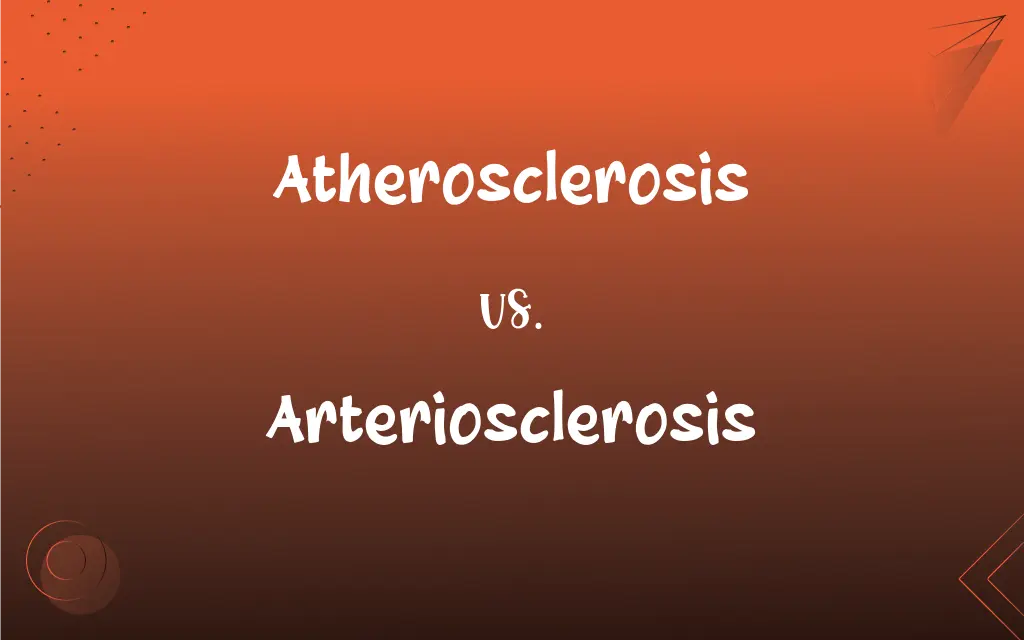Atherosclerosis vs. Arteriosclerosis: What's the Difference?
Edited by Janet White || By Harlon Moss || Updated on October 29, 2023
Atherosclerosis involves the build-up of fats and cholesterol, causing plaque formation, while arteriosclerosis is the hardening of arteries.

Key Differences
Atherosclerosis is a specific type of arteriosclerosis that involves the build-up of fats, cholesterol, and other substances in and on the artery walls. This build-up, known as plaque, can restrict blood flow. Atherosclerosis can lead to serious problems, including heart disease, stroke, and peripheral arterial disease.
Arteriosclerosis is a broader term that refers to the hardening and loss of elasticity of arteries. While atherosclerosis is a form of arteriosclerosis, there are other forms of arteriosclerosis, such as Monckeberg’s medial calcific sclerosis and arterial fibrosis. Arteriosclerosis can occur due to aging, high blood pressure, diabetes, and other factors.
It is important to note that while atherosclerosis often leads to arteriosclerosis, not all cases of arteriosclerosis are caused by atherosclerosis. The distinction between the two terms can be subtle, but understanding the difference is crucial for proper diagnosis and treatment.
In conclusion, while both atherosclerosis and arteriosclerosis involve the arteries, they are distinct conditions. Atherosclerosis is a specific form of arteriosclerosis characterized by the buildup of plaque in the arteries, which can restrict blood flow and lead to serious cardiovascular problems.
Comparison Chart
Definition
Build-up of fats and cholesterol
Hardening of arteries
ADVERTISEMENT
Causes
High cholesterol, hypertension
Aging, high blood pressure, diabetes
Conditions
Heart disease, stroke, PAD
Various cardiovascular problems
Forms
Specific form of arteriosclerosis
Includes atherosclerosis, other forms
Treatment
Lifestyle changes, medications
Depends on the form and cause
Atherosclerosis and Arteriosclerosis Definitions
Atherosclerosis
Atherosclerosis is a type of arteriosclerosis.
While all atherosclerosis is arteriosclerosis, not all arteriosclerosis is atherosclerosis.
ADVERTISEMENT
Arteriosclerosis
Arteriosclerosis can be caused by high blood pressure and diabetes.
Managing blood pressure and diabetes is crucial in preventing arteriosclerosis.
Atherosclerosis
Atherosclerosis is caused by high cholesterol and hypertension.
A healthy diet and regular exercise can help prevent atherosclerosis.
Arteriosclerosis
Arteriosclerosis is the hardening of the arteries.
Arteriosclerosis can lead to reduced blood flow and cardiovascular problems.
Atherosclerosis
Atherosclerosis can be treated with lifestyle changes and medications.
Statins are often prescribed to treat atherosclerosis.
Arteriosclerosis
Arteriosclerosis can occur due to aging.
Arteriosclerosis is more common in older adults.
Atherosclerosis
Atherosclerosis is the build-up of fats and cholesterol in the arteries.
Atherosclerosis can restrict blood flow and lead to cardiovascular problems.
Arteriosclerosis
Arteriosclerosis includes various forms, such as atherosclerosis.
Atherosclerosis is a specific form of arteriosclerosis.
Atherosclerosis
Atherosclerosis can lead to serious conditions like heart disease.
Managing cholesterol levels is crucial in preventing atherosclerosis.
Arteriosclerosis
Arteriosclerosis can be treated depending on the cause and form.
Medications and lifestyle changes can help treat arteriosclerosis.
FAQs
What is arteriosclerosis?
The hardening of the arteries.
What is atherosclerosis?
The build-up of fats and cholesterol in the arteries.
Is atherosclerosis a form of arteriosclerosis?
Yes, atherosclerosis is a specific form of arteriosclerosis.
Can atherosclerosis lead to cardiovascular problems?
Yes, atherosclerosis can restrict blood flow and lead to serious cardiovascular problems.
Is diabetes a cause of arteriosclerosis?
Yes, diabetes can cause arteriosclerosis.
What causes atherosclerosis?
High cholesterol levels and hypertension are common causes of atherosclerosis.
Are there different forms of arteriosclerosis?
Yes, there are various forms of arteriosclerosis, including atherosclerosis.
Is managing cholesterol levels important for preventing atherosclerosis?
Yes, managing cholesterol levels is crucial in preventing atherosclerosis.
How can atherosclerosis be treated?
Lifestyle changes and medications can be used to treat atherosclerosis.
Is arteriosclerosis common in older adults?
Yes, arteriosclerosis is more common in older adults.
Can medications treat arteriosclerosis?
Yes, medications can be used to treat arteriosclerosis.
Are there medications for treating atherosclerosis?
Yes, there are medications specifically for treating atherosclerosis.
How can arteriosclerosis be treated?
Treatment for arteriosclerosis depends on the cause and form.
Can arteriosclerosis restrict blood flow?
Yes, arteriosclerosis can lead to reduced blood flow.
What causes arteriosclerosis?
Aging, high blood pressure, and diabetes can cause arteriosclerosis.
Can lifestyle changes prevent atherosclerosis?
Yes, a healthy diet and regular exercise can help prevent atherosclerosis.
Can a healthy diet prevent arteriosclerosis?
A healthy diet can help prevent arteriosclerosis.
Can regular exercise prevent arteriosclerosis?
Regular exercise can help prevent arteriosclerosis.
Is managing blood pressure important for preventing arteriosclerosis?
Yes, managing blood pressure is crucial in preventing arteriosclerosis.
Are statins used to treat atherosclerosis?
Yes, statins are often prescribed to treat atherosclerosis.
About Author
Written by
Harlon MossHarlon is a seasoned quality moderator and accomplished content writer for Difference Wiki. An alumnus of the prestigious University of California, he earned his degree in Computer Science. Leveraging his academic background, Harlon brings a meticulous and informed perspective to his work, ensuring content accuracy and excellence.
Edited by
Janet WhiteJanet White has been an esteemed writer and blogger for Difference Wiki. Holding a Master's degree in Science and Medical Journalism from the prestigious Boston University, she has consistently demonstrated her expertise and passion for her field. When she's not immersed in her work, Janet relishes her time exercising, delving into a good book, and cherishing moments with friends and family.































































